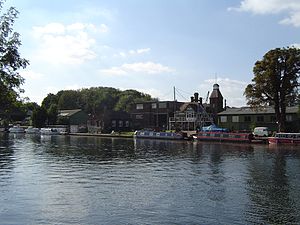Platt's Eyot
| Platt's Eyot | ||
|---|---|---|
| Platt's Eyot boat launch | ||
| Waters | Thames | |
| Geographical location | 51 ° 25 ′ N , 0 ° 22 ′ W | |
|
|
||
| The bridge to the island | ||
Platt's Eyot or Platt's Ait is an island in the Thames near Hampton , in the London Borough of Richmond upon Thames , England , between Molesey Lock and Sunbury Lock .
geography
The island was a typical Werder that was used to raise pastures . It was also used to store overburden from the construction of the Stain Hill Reservoir , creating a large hill at the western end of the island. A suspension bridge connects the island with Hampton. The entire island has been classified as the River Thames site of Metropolitan Importance for Nature Conservation and the western end is part of the Metropolitan Green Belt . It is the westernmost island of the Thames in Greater London . The island is a landscaped and structurally protected conservation area .
history
The name of the island goes back to a man named Platt from Molesey , who raised pastures on the island.
Boat building began on the island in 1868 when Thomas Tagg, who had run a business on Tagg's Island about 1 km downriver since 1841 , built a workshop and house on the eastern end of the island. A waterworks and a charging station for electrically powered pleasure boats have also been built on the island.
Around 1904, John Isaac Thornycroft opened the Hampton Launch Works, an offshoot of his boat building company in Chiswick which he had founded in the 1860s. This operation focused on the construction of open and closed pleasure boats. The company's success caught the attention of the Navy and resulted in corresponding orders. A new major operation was in Southampton was opened, which was the main site of the company, but on the island were in the First and Second World War, small boats for the British Navy built. In 1916, the Navy commissioned a new, high-speed torpedo- armed motorboat that Thorneycroft built under secrecy on the island. Around this time four new boat sheds were built on the island. The halls were designed by Augustine Alban Hamilton Scott and built using the Belfast truss system, which had been developed during World War I to build large hall roofs like those used on aircraft hangers. Only a few boat sheds were built this way.
During the Second World War, motor torpedo boats , motor boats and landing craft were used in the operation . Thornycrofts stopped shipbuilding on the island when the company merged with Vosper & Co in 1966 . The island was bought by Port Hampton Ltd. , which set up a number of different industries on the island.
In 1941 the island was connected to Hampton by a suspension bridge built by the Royal Electrical and Mechanical Engineers .
The administrative affiliation of the island was transferred on April 1, 1970 from Esher Urban District in Surrey to the London Borough of Richmond upon Thames in Greater London. The transfer was based on the London Government Act 1963 .
See also
Individual evidence
- ↑ Platt's Eyot Conservation Area 58 - Richmond upon Thames Government
- ↑ a b Stephen Croad: Liquid History: The Thames Through Time . Batsford, 2003, ISBN 978-0-7134-8834-0 , p. 17.
- ^ The Greater London and Surrey Order, 1970
- ↑ https://www.thegazette.co.uk/London/issue/45021/page/666


